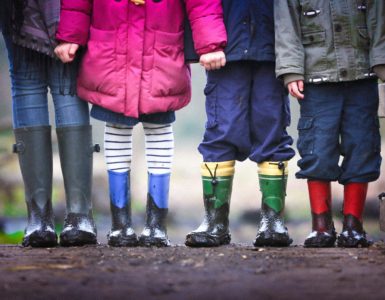Current statistics have revealed that it can take up to six years from start to finish to be matched with an infant and finalize an adoption. Sometimes it happens more quickly. Sometimes it takes the full six years. That can feel like an eternity when prospective parents are hoping to build a family. So, are there other options? What about adopting an older child from the foster care system?
There are many benefits of adopting a child. Consider how adopting an older child from foster care can fulfill your vision for a forever family.
1. Become a part of a support system.
Children develop a need for a forever family in a variety of ways. Either the adults in their lives have failed them directly, or some other issues have lead to their need for a newm safe home. It could be due to neglect or more intense situations such as abuse. Whenever this occurs in a child’s life, it always causes some developmental delays. When adopting an older child, there are often already services in place to assist them in understanding what has happened to them. Mechanisms that help children cope may already be an attached constant in their lives. When you start with an infant, it is a learning process along the way. As a parent, in many cases, you don’t know what you don’t know until it happens. One of the benefits of adopting a child that has aged a bit is that they may already have issues that have been previously identified. Along with that, there may already be aids in place to overcome or cope with those issues. With the help of a strong group of professionals working together as a team, parents can successfully work towards the best outcome for their child. One of the benefits of adopting an older child is becoming a part of that child’s support system.
2. Develop a greater understanding.
At some stage, every adopted child will likely learn that they came into the family via the legal system, rather than through more routine biological means. Younger children may feel as though they were victims of a system far beyond their control. They had no choice in being born and no choice in being placed for adoption. At some point, every adoptee who was adopted as an infant will have to work their way through the maze of emotions that their circumstances instroduce. Not every child who is older has a choice in the matter either. Many children would rather have the adults that brought them into the world become different people who are ready, willing, and able to support them every day. Since that is no longer an option for older, adoptable children, there are ways to involve an older child in their own adoption. Teenagers, in some states, get a voice in the courts; but there are ways others can help young children learn about and be involved in their own adoption process. They have a history they may or may not remember, but they’ll likely be able to understand a bit more what it means to have a safe home, daily support, and constant love.
3. Adopt multiples.
If prospective parents have always dreamed of a big family, this may be just the route to achieve that dream. Children over 5 are typically considered more difficult to place; yet many children need a new family starting between 5-7 years old. Some are deemed difficult to place not only because of their age, but also due to the fact that they may need a home that will be capable of accepting, loving, and nurturing their brothers and sisters. It’s not only infants that are relinquished. Often sibling groups of two or more children need a new home. With the stability of parents shifting, siblings can be a great comfort to each other. There is no denying that siblings have a unique bond. Siblings may have an intimate understanding of the circumstances that brought them through the adoption process. Being able to keep siblings together is usually preferred. It can help reinforce their bonds and offer some comfort during the transition from a biological family situation to foster care to adoption.
4. Fulfill the family dream.
Adoption is a thing born of trauma, but it’s also an opportunity to provide help, security, love, and support for someone who would otherwise be left to move through the foster care system until they age out. Take a moment and imagine what it would be like as a young adult to have nowhere to go to celebrate holidays. What would it be like to be a child and not be able to participate in community sports, camps, or other activities because you’re a ward of the state. Take a moment and imagine being introduced to strangers-turned-roommates several times a year. Think about what it would be like never knowing exactly where you’ll lay your head at night. It’s suddenly easy to see that the dream of family is a completely valid reason to adopt. Adoption can help the prospective parents realize a dream, as well as help a child (or children) who desperately need stable circumstances.
5. Embrace a Routine.
Personally speaking from my experience as an adoptee, setting things like family traditions around the holidays and even the stability of a day-to-day routine were anchoring. Routine becomes a foundation for adoptees as well. Many older children are coming from a background of instability either created in their home or through the stressors of the foster care system. Building a schedule that everyone can manage can be a fun and easy way to secure bonds and add stability to a child’s life. Introducing a child to family traditions you may already have in place, as well as creating some together, are rewarding to all parties involved.
6. Expand Your Circle.
Adoptions have come a long way. Most adoptions are open on a variety of levels. This gives the adoptee a chance to understand where they came from. It also gives the prospective adoptive family a chance to foster kinship relationships in a manner that is safe for everyone. For example, some families opt to email the biological family photos or stories of how the adoptee is doing. Others meet up in parks and public areas for playdates. Some even invite the biological parents over for milestones like birthdays and family gatherings. Yet for others, the best route may be a highly limited form of contact (say, if one parent happens to be in jail, or if there is a history of ongoing abuse). Adopting a child means understanding (as best as possible) that an adoptee’s life didn’t start the moment they met you. The circumstances may differ (based on each child’s unique scenario).
7. Expanding your worldview.
The willingness to embrace every aspect of a new addition to the family is one amazing thing about adoption that cannot be replicated any other way. Integrating a new cultural aspect into an existing family can be an exciting, life-long journey. Choosing an international adoption gives families a chance to reach beyond their cultural horizons and open their hearts and homes to the cultures of the world. Even in domestic adoption, adopting a child from a different cultural background can open up opportunities to learn and expand world views.. The adoptive family, in these cases, can make a plan to integrate the child’s culture of origin into their new forever family.
8. Jump into family life.
There are thousands of children available throughout the world that need families to support them into adulthood and beyond. Adoption agencies can help prospective adoptive parents find a child (or children) that may benefit from what that specific family has to offer. Some prospective parents have a heart and the resources to reach out and help special needs children who can’t live with their biological family. A dedicated family can make a significant difference in the life of a child. Maybe teenagers sound like a better fit for your family. That’s more than possible as well. Seeing someone through the challenges of high school and into their future is something every parent is going to have to deal with sooner than later. If a prospective adoptive family can start there, during one of the most difficult transitions in a young adult’s life, it can have a profound impact on that child’s trajectory into the future. Between 20,000 and 30,000 children age out of foster care each year. Most will battle with homelessness and all the challenges that come with that. Addiction and poverty are very real dangers for older children who are aging out of foster care. Jumping into someone’s life in their teen years may seem daunting. If you were to consider, though, what that teen’s path may lead to if a prospective family doesn’t jump in to help shift and ease their transition into adulthood, you may reconsider your own apprehensions.
Some prospective adoptive parents have suffered through infertility issues that lead them to adoption. Biological families are either faced with an incredibly difficult decision (to place their children for adoption). Some biological parents are simply at the point where they must accept that they cannot care for their children and they must place their child in foster care. These children have no choice over the circumstance they find themselves in, no matter how they got there. Attitudes and behaviors that may have developed as coping skills against abuse can make it seem easier to adopt an infant who doesn’t have the interpersonal history that an older child may have. Speaking as an adoptee that was placed for adoption at birth and doesn’t have a history of abuse or neglect, I can say, I came with my own issues. No one is immune to some sort of issue. (Even children who don’t come into a family as an adoptee find something they struggle with.) But The benefits of adopting a child means they already have a village in place to support them through whatever challenges they are currently facing and whatever may come.
Every person has their own history. Every child has their own story. One such story involves friends of mine I met through foster care training classes. A couple looking to adopt and add to their family was matched with a little boy within a few weeks of receiving their foster care license. They worked through new issues as they arose and were able to adopt him as a 5-year-old. They were considering adding to their family and remained connected to their son’s foster and biological families. They learned of their son’s best friend he’d met in foster care who also was becoming legally eligible for adoption. This little boy had Type 1 diabetes which is a challenge to treat in someone so young. Under the stress of foster care, these challenges became even more weighty. They decided to foster him and see how the two best friends might get along as brothers. It was a hit. Soon enough the two boys were truly brothers and were adopted into the same family.
Not every foster childhood has that kind of silver lining. But for prospective parents looking to make an impact, save a life, and add to their family, the benefits of adopting a child may outweigh the many unforeseeable challenges that come with parenthood. Leaning on a village of support, it’s possible to find some measures of healing through something born out of an extreme challenge. Families come in all different shapes and sizes. What does yours look like?




